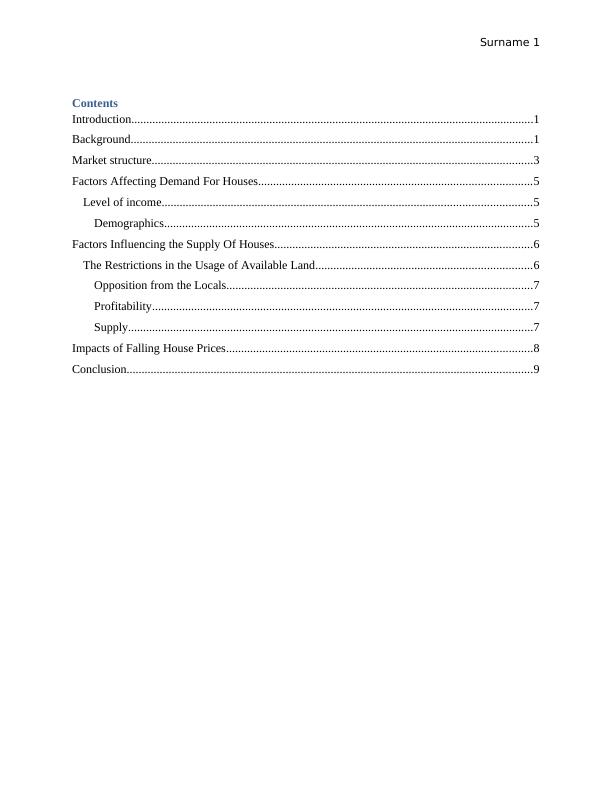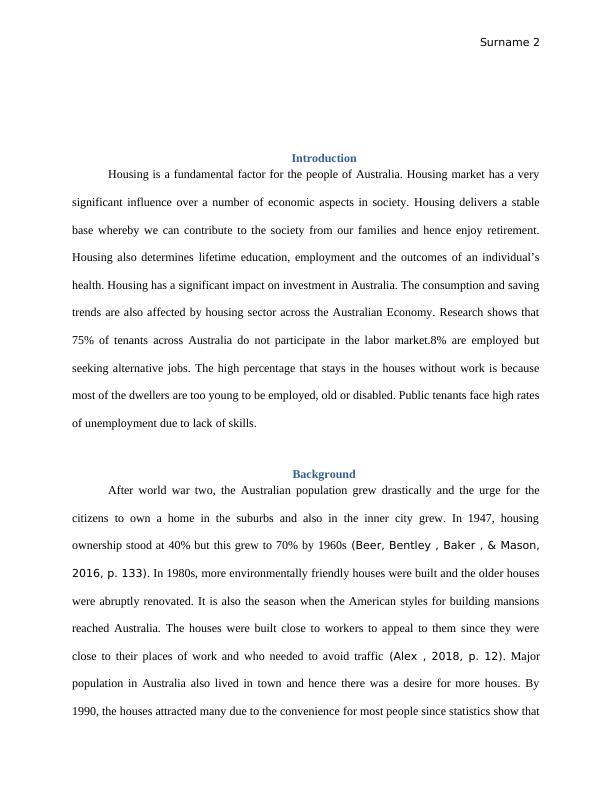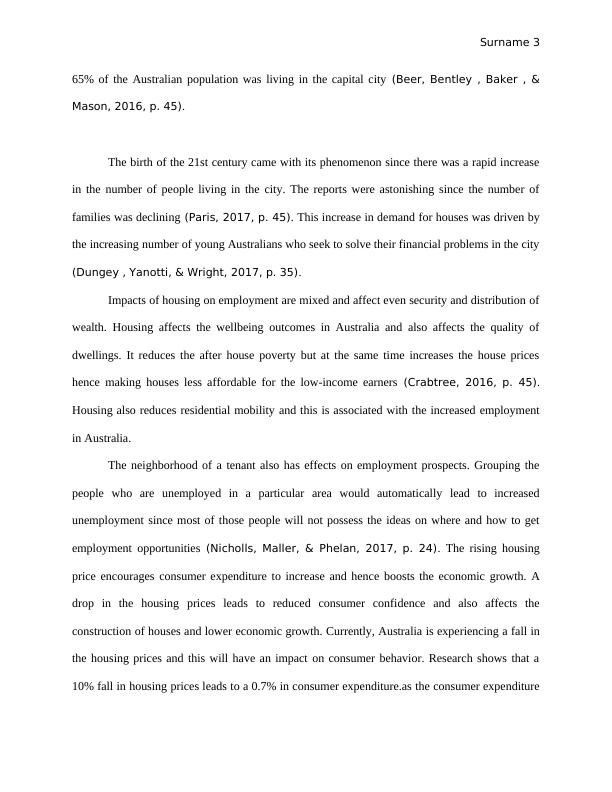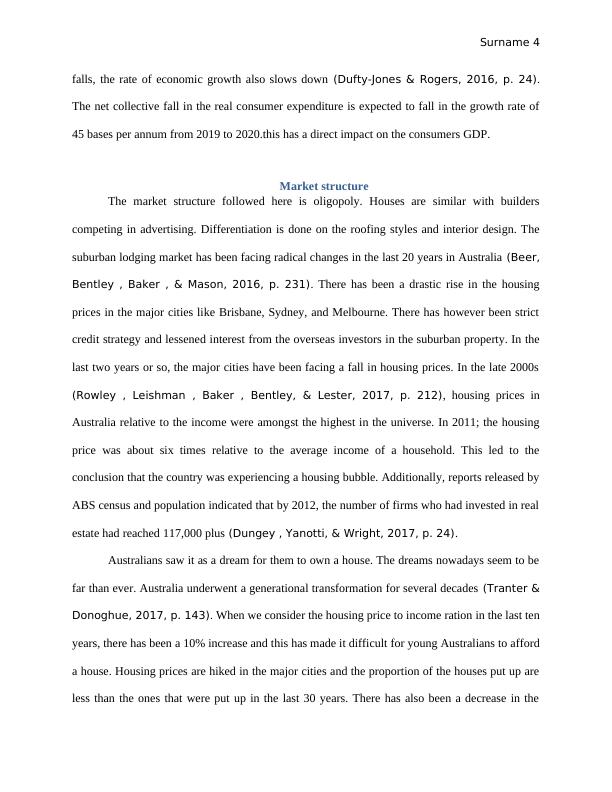Factors Affecting Demand and Supply of Houses in Australia
Added on 2022-11-16
11 Pages3063 Words409 Views
Surname 1
Contents
Introduction......................................................................................................................................1
Background......................................................................................................................................1
Market structure...............................................................................................................................3
Factors Affecting Demand For Houses...........................................................................................5
Level of income...........................................................................................................................5
Demographics...........................................................................................................................5
Factors Influencing the Supply Of Houses......................................................................................6
The Restrictions in the Usage of Available Land........................................................................6
Opposition from the Locals......................................................................................................7
Profitability...............................................................................................................................7
Supply.......................................................................................................................................7
Impacts of Falling House Prices......................................................................................................8
Conclusion.......................................................................................................................................9
Contents
Introduction......................................................................................................................................1
Background......................................................................................................................................1
Market structure...............................................................................................................................3
Factors Affecting Demand For Houses...........................................................................................5
Level of income...........................................................................................................................5
Demographics...........................................................................................................................5
Factors Influencing the Supply Of Houses......................................................................................6
The Restrictions in the Usage of Available Land........................................................................6
Opposition from the Locals......................................................................................................7
Profitability...............................................................................................................................7
Supply.......................................................................................................................................7
Impacts of Falling House Prices......................................................................................................8
Conclusion.......................................................................................................................................9

Surname 2
Introduction
Housing is a fundamental factor for the people of Australia. Housing market has a very
significant influence over a number of economic aspects in society. Housing delivers a stable
base whereby we can contribute to the society from our families and hence enjoy retirement.
Housing also determines lifetime education, employment and the outcomes of an individual’s
health. Housing has a significant impact on investment in Australia. The consumption and saving
trends are also affected by housing sector across the Australian Economy. Research shows that
75% of tenants across Australia do not participate in the labor market.8% are employed but
seeking alternative jobs. The high percentage that stays in the houses without work is because
most of the dwellers are too young to be employed, old or disabled. Public tenants face high rates
of unemployment due to lack of skills.
Background
After world war two, the Australian population grew drastically and the urge for the
citizens to own a home in the suburbs and also in the inner city grew. In 1947, housing
ownership stood at 40% but this grew to 70% by 1960s (Beer, Bentley , Baker , & Mason,
2016, p. 133). In 1980s, more environmentally friendly houses were built and the older houses
were abruptly renovated. It is also the season when the American styles for building mansions
reached Australia. The houses were built close to workers to appeal to them since they were
close to their places of work and who needed to avoid traffic (Alex , 2018, p. 12). Major
population in Australia also lived in town and hence there was a desire for more houses. By
1990, the houses attracted many due to the convenience for most people since statistics show that
Introduction
Housing is a fundamental factor for the people of Australia. Housing market has a very
significant influence over a number of economic aspects in society. Housing delivers a stable
base whereby we can contribute to the society from our families and hence enjoy retirement.
Housing also determines lifetime education, employment and the outcomes of an individual’s
health. Housing has a significant impact on investment in Australia. The consumption and saving
trends are also affected by housing sector across the Australian Economy. Research shows that
75% of tenants across Australia do not participate in the labor market.8% are employed but
seeking alternative jobs. The high percentage that stays in the houses without work is because
most of the dwellers are too young to be employed, old or disabled. Public tenants face high rates
of unemployment due to lack of skills.
Background
After world war two, the Australian population grew drastically and the urge for the
citizens to own a home in the suburbs and also in the inner city grew. In 1947, housing
ownership stood at 40% but this grew to 70% by 1960s (Beer, Bentley , Baker , & Mason,
2016, p. 133). In 1980s, more environmentally friendly houses were built and the older houses
were abruptly renovated. It is also the season when the American styles for building mansions
reached Australia. The houses were built close to workers to appeal to them since they were
close to their places of work and who needed to avoid traffic (Alex , 2018, p. 12). Major
population in Australia also lived in town and hence there was a desire for more houses. By
1990, the houses attracted many due to the convenience for most people since statistics show that

Surname 3
65% of the Australian population was living in the capital city (Beer, Bentley , Baker , &
Mason, 2016, p. 45).
The birth of the 21st century came with its phenomenon since there was a rapid increase
in the number of people living in the city. The reports were astonishing since the number of
families was declining (Paris, 2017, p. 45). This increase in demand for houses was driven by
the increasing number of young Australians who seek to solve their financial problems in the city
(Dungey , Yanotti, & Wright, 2017, p. 35).
Impacts of housing on employment are mixed and affect even security and distribution of
wealth. Housing affects the wellbeing outcomes in Australia and also affects the quality of
dwellings. It reduces the after house poverty but at the same time increases the house prices
hence making houses less affordable for the low-income earners (Crabtree, 2016, p. 45).
Housing also reduces residential mobility and this is associated with the increased employment
in Australia.
The neighborhood of a tenant also has effects on employment prospects. Grouping the
people who are unemployed in a particular area would automatically lead to increased
unemployment since most of those people will not possess the ideas on where and how to get
employment opportunities (Nicholls, Maller, & Phelan, 2017, p. 24). The rising housing
price encourages consumer expenditure to increase and hence boosts the economic growth. A
drop in the housing prices leads to reduced consumer confidence and also affects the
construction of houses and lower economic growth. Currently, Australia is experiencing a fall in
the housing prices and this will have an impact on consumer behavior. Research shows that a
10% fall in housing prices leads to a 0.7% in consumer expenditure.as the consumer expenditure
65% of the Australian population was living in the capital city (Beer, Bentley , Baker , &
Mason, 2016, p. 45).
The birth of the 21st century came with its phenomenon since there was a rapid increase
in the number of people living in the city. The reports were astonishing since the number of
families was declining (Paris, 2017, p. 45). This increase in demand for houses was driven by
the increasing number of young Australians who seek to solve their financial problems in the city
(Dungey , Yanotti, & Wright, 2017, p. 35).
Impacts of housing on employment are mixed and affect even security and distribution of
wealth. Housing affects the wellbeing outcomes in Australia and also affects the quality of
dwellings. It reduces the after house poverty but at the same time increases the house prices
hence making houses less affordable for the low-income earners (Crabtree, 2016, p. 45).
Housing also reduces residential mobility and this is associated with the increased employment
in Australia.
The neighborhood of a tenant also has effects on employment prospects. Grouping the
people who are unemployed in a particular area would automatically lead to increased
unemployment since most of those people will not possess the ideas on where and how to get
employment opportunities (Nicholls, Maller, & Phelan, 2017, p. 24). The rising housing
price encourages consumer expenditure to increase and hence boosts the economic growth. A
drop in the housing prices leads to reduced consumer confidence and also affects the
construction of houses and lower economic growth. Currently, Australia is experiencing a fall in
the housing prices and this will have an impact on consumer behavior. Research shows that a
10% fall in housing prices leads to a 0.7% in consumer expenditure.as the consumer expenditure

Surname 4
falls, the rate of economic growth also slows down (Dufty-Jones & Rogers, 2016, p. 24).
The net collective fall in the real consumer expenditure is expected to fall in the growth rate of
45 bases per annum from 2019 to 2020.this has a direct impact on the consumers GDP.
Market structure
The market structure followed here is oligopoly. Houses are similar with builders
competing in advertising. Differentiation is done on the roofing styles and interior design. The
suburban lodging market has been facing radical changes in the last 20 years in Australia (Beer,
Bentley , Baker , & Mason, 2016, p. 231). There has been a drastic rise in the housing
prices in the major cities like Brisbane, Sydney, and Melbourne. There has however been strict
credit strategy and lessened interest from the overseas investors in the suburban property. In the
last two years or so, the major cities have been facing a fall in housing prices. In the late 2000s
(Rowley , Leishman , Baker , Bentley, & Lester, 2017, p. 212), housing prices in
Australia relative to the income were amongst the highest in the universe. In 2011; the housing
price was about six times relative to the average income of a household. This led to the
conclusion that the country was experiencing a housing bubble. Additionally, reports released by
ABS census and population indicated that by 2012, the number of firms who had invested in real
estate had reached 117,000 plus (Dungey , Yanotti, & Wright, 2017, p. 24).
Australians saw it as a dream for them to own a house. The dreams nowadays seem to be
far than ever. Australia underwent a generational transformation for several decades (Tranter &
Donoghue, 2017, p. 143). When we consider the housing price to income ration in the last ten
years, there has been a 10% increase and this has made it difficult for young Australians to afford
a house. Housing prices are hiked in the major cities and the proportion of the houses put up are
less than the ones that were put up in the last 30 years. There has also been a decrease in the
falls, the rate of economic growth also slows down (Dufty-Jones & Rogers, 2016, p. 24).
The net collective fall in the real consumer expenditure is expected to fall in the growth rate of
45 bases per annum from 2019 to 2020.this has a direct impact on the consumers GDP.
Market structure
The market structure followed here is oligopoly. Houses are similar with builders
competing in advertising. Differentiation is done on the roofing styles and interior design. The
suburban lodging market has been facing radical changes in the last 20 years in Australia (Beer,
Bentley , Baker , & Mason, 2016, p. 231). There has been a drastic rise in the housing
prices in the major cities like Brisbane, Sydney, and Melbourne. There has however been strict
credit strategy and lessened interest from the overseas investors in the suburban property. In the
last two years or so, the major cities have been facing a fall in housing prices. In the late 2000s
(Rowley , Leishman , Baker , Bentley, & Lester, 2017, p. 212), housing prices in
Australia relative to the income were amongst the highest in the universe. In 2011; the housing
price was about six times relative to the average income of a household. This led to the
conclusion that the country was experiencing a housing bubble. Additionally, reports released by
ABS census and population indicated that by 2012, the number of firms who had invested in real
estate had reached 117,000 plus (Dungey , Yanotti, & Wright, 2017, p. 24).
Australians saw it as a dream for them to own a house. The dreams nowadays seem to be
far than ever. Australia underwent a generational transformation for several decades (Tranter &
Donoghue, 2017, p. 143). When we consider the housing price to income ration in the last ten
years, there has been a 10% increase and this has made it difficult for young Australians to afford
a house. Housing prices are hiked in the major cities and the proportion of the houses put up are
less than the ones that were put up in the last 30 years. There has also been a decrease in the

End of preview
Want to access all the pages? Upload your documents or become a member.
Related Documents
Housing Affordability Crisis in Sydney and Melbournelg...
|10
|2208
|297
Impacts Of House Prices On Socioeconomic Factorslg...
|12
|4063
|145
Social Determinants of Health in a Case Studylg...
|10
|2558
|99
Census 2016: Five ways Australia is getting more diverselg...
|10
|1101
|201
Business Demographics | Population Growth in NSWlg...
|15
|2271
|29
THE REAL ESTATE INDUSTRY.lg...
|23
|5639
|10
